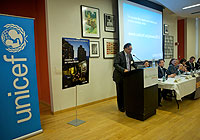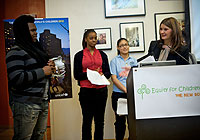The State of the World's Children
Experts discuss issues raised in UNICEF's flagship report at panel discussion in New York
 |
| © UNICEF/2012/Shi |
| Khaled Mansour, UNICEF Director of the Division of Communication, speaks at a panel discussion about UNICEF's flagship publication, 'The State of the World's Children 2012', in New York City. |
By Priyanka Pruthi
NEW YORK, US, 8 March 2012 – For 15-year-old Shakora Townsend, growing up in one of the toughest neighborhoods in New York City has made living with poverty, violence and discrimination a part of her daily life.
“I shouldn’t be defined by where I was born. People see children who live in public housing or whose parents are on food stamps and think that we don’t have any goals of our own. They are wrong,” she said.
Speaking on behalf of hundreds of millions of children living in urban poverty at a panel discussion co-hosted by UNICEF at the New School in New York, Shakora, along with other representatives from the ATD (All Together in Dignity) Fourth World Movement Youth Group, urged governments and policy makers to address the needs of children being left behind in booming cities.
“Our families do all that they can and more, but when resources are scarce and unemployment is high, they have to ask for our support. We are proud to rise to the challenge of contributing to our families, but the actual responsibility has an impact on our academic performance,” said teenager Maysha Prince.
Highlighting inequities
At the event, a panel of development experts, professors and government officials addressed the questions and issues raised in UNICEF’s flagship publication, ‘The State of the World’s Children 2012: Children in an Urban World’.
 |
| © UNICEF/2012/Shi |
| Moderator and UNICEF Research Officer Nikola Balvinintroduces representatives of youth group ATD Fourth World Movement at a panel discussion in New York City. |
“Hundreds of millions of children live in informal settlements and slums under some of the most challenging conditions on earth. They endure hunger, they endure ill health and the denial of such crucial services as education, clean water and sanitation. This should inspire shame and action on the part of the political, commercial and cultural elites who live in the very same cities,” said Khaled Mansour, Director of the UNICEF Division of Communication.
‘The State of the World’s Children 2012’ highlights the sharp disparities that are found in urban areas between children from poorer households and those from wealthier households.
“We’re looking at meeting a critical mass or tipping point. And maybe today is the beginning of a new era of working in urban areas for development organizations….to address the imbalances and inequities that are very apparent in the world today,” Robert Jenkins, Associate Director of UNICEF’s Division of Policy and Practice.
More research needed
With the explosive growth of urban populations – almost half of the world’s children now live in urban areas – experts say that understanding the location, scale and nature of poverty affecting children is the necessary first step to reaching those left behind.
“If you have some material deprivation and you are discriminated against…you are amongst the poorest of the poor and in the exclusion area – but we don’t have too much information on these people,” said Alberto Minujin, Director of ‘Equity for Children’ at the New School.
 |
| © UNICEF/2012/Shi |
| Audience members watch a panel discussion about UNICEF's 'State of the World's Children 2012' report in New York City. |
“They are living not in the mega cities but in a myriad of smaller cities and towns,” said Mark Montogmery, an economics professor at the State University of New York at Stony Brook. “We need to set aside these misconceptions of urbanization and urban poverty so we are not misled. We need to keep the smaller urban places in our minds as we devise policies and programs. Be careful about over-focusing on slums. And we need to give attention to migration and mobility.”
Listening to children’s voices
‘The Child Friendly Cities model’ is a potential framework for government officials and development organizations, suggested Pamela Wridt, the Co-Director of the Children’s Environments Research group at the Graduate Center of the City University of New York.
“A Child Friendly City is a city that’s committed to a process for the realization of children’s rights. At the core of it is child participation – children’s voices and concerns and matters for young people,” said Pamela Wridt. “Young people can lead assessments about their rights, they can generate valid, reliable data that administrators, mayors and researchers can count on,” she said.
Commissioner Jeanne B. Mullgrav of New York City’s Department of Youth and Community Development (DYCD) agreed, speaking of her department’s efforts to seek out the perspectives of young people. “Much of what we do is to get guidance from young people… The unifying principles that drive DYCD are equity, accountability and maximizing community engagement.”
People living in urban poverty must also be included in decision-making processes, experts emphasized.
“What the urban poor need and what they deserve now – beyond improved services delivery and as a pre-requisite for improved services – is inclusion,” said Khaled Mansour. “Positive change follows when the excluded are no longer shunned but instead granted the right to take part in local decision-making. After all, who else is better and more qualified than them to help identify the challenges and to devise the solutions.”
Shakora echoed these sentiments. “People can’t speak for us... But when we get to speak on behalf of ourselves and our experiences, that’s a positive step.”

